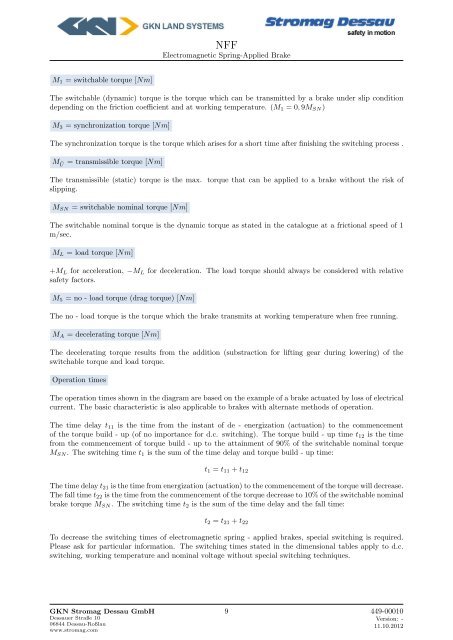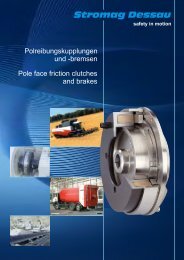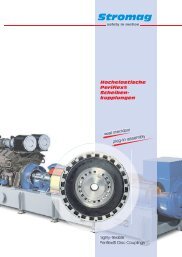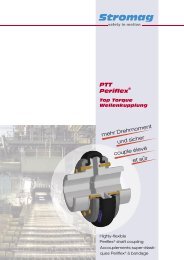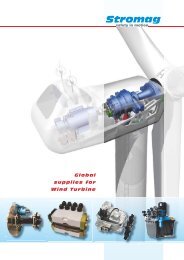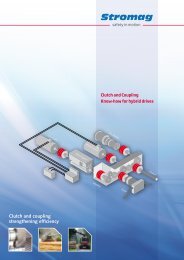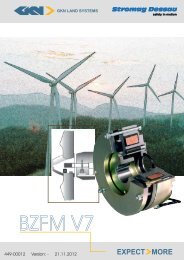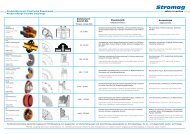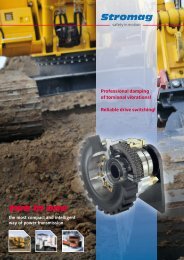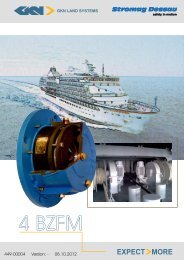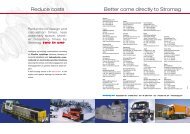Stromag Dessau EXPECT MORE
Stromag Dessau EXPECT MORE
Stromag Dessau EXPECT MORE
Create successful ePaper yourself
Turn your PDF publications into a flip-book with our unique Google optimized e-Paper software.
M1 = switchable torque [Nm]<br />
NFF<br />
Electromagnetic Spring-Applied Brake<br />
The switchable (dynamic) torque is the torque which can be transmitted by a brake under slip condition<br />
depending on the friction coefficient and at working temperature. (M1 = 0, 9MSN)<br />
M3 = synchronization torque [Nm]<br />
The synchronization torque is the torque which arises for a short time after finishing the switching process .<br />
M Ü<br />
= transmissible torque [Nm]<br />
The transmissible (static) torque is the max. torque that can be applied to a brake without the risk of<br />
slipping.<br />
MSN = switchable nominal torque [Nm]<br />
The switchable nominal torque is the dynamic torque as stated in the catalogue at a frictional speed of 1<br />
m/sec.<br />
ML = load torque [Nm]<br />
+ML for acceleration, −ML for deceleration. The load torque should always be considered with relative<br />
safety factors.<br />
M5 = no - load torque (drag torque) [Nm]<br />
The no - load torque is the torque which the brake transmits at working temperature when free running.<br />
MA = decelerating torque [Nm]<br />
The decelerating torque results from the addition (substraction for lifting gear during lowering) of the<br />
switchable torque and load torque.<br />
Operation times<br />
The operation times shown in the diagram are based on the example of a brake actuated by loss of electrical<br />
current. The basic characteristic is also applicable to brakes with alternate methods of operation.<br />
The time delay t11 is the time from the instant of de - energization (actuation) to the commencement<br />
of the torque build - up (of no importance for d.c. switching). The torque build - up time t12 is the time<br />
from the commencement of torque build - up to the attainment of 90% of the switchable nominal torque<br />
MSN. The switching time t1 is the sum of the time delay and torque build - up time:<br />
t1 = t11 + t12<br />
The time delay t21 is the time from energization (actuation) to the commencement of the torque will decrease.<br />
The fall time t22 is the time from the commencement of the torque decrease to 10% of the switchable nominal<br />
brake torque MSN. The switching time t2 is the sum of the time delay and the fall time:<br />
t2 = t21 + t22<br />
To decrease the switching times of electromagnetic spring - applied brakes, special switching is required.<br />
Please ask for particular information. The switching times stated in the dimensional tables apply to d.c.<br />
switching, working temperature and nominal voltage without special switching techniques.<br />
GKN <strong>Stromag</strong> <strong>Dessau</strong> GmbH<br />
<strong>Dessau</strong>er Straße 10<br />
06844 <strong>Dessau</strong>-Roßlau<br />
www.stromag.com<br />
9 449-00010<br />
Version: -<br />
11.10.2012


